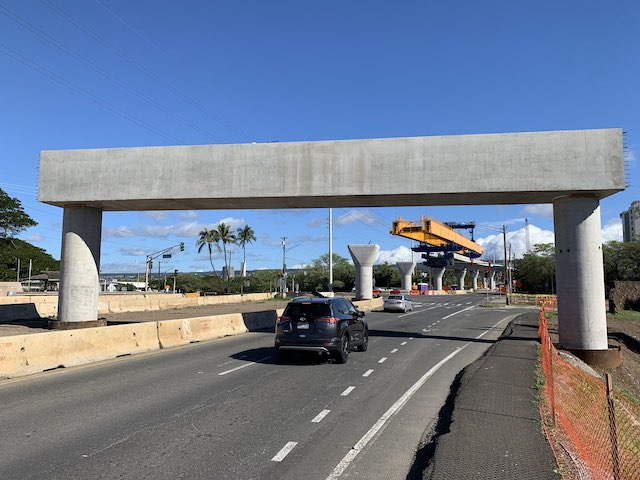The first phase of the Honolulu rail transit system is supposed to open at the end of this year, with trains serving nine of the planned 21 stations. But those plans may be put on hold because contractors have discovered cracks in the concrete pillars holding up the elevated stations. Due to these cracks, the consultants have “advised that passengers not be allowed into the seven affected stations until further inspections are done.”
The Honolulu rail project was idiotically designed to be entirely elevated, creating problems both with scenic views and differential settling in swampy land.
That leaves just two stations that might open later this year. Most likely, none will open at all. What is known for sure is that the cracks are growing.
This is just the latest in a long line of snafus over the Honolulu transit project. These include wheels that turned out to be too narrow for the rails they are to run on, electric power that is likely to disrupt nearby homes and businesses, and a 140 percent cost overrun. Current plans call for the project to be finished a mere 11 years late, but that’s optimistic.
If this project were competently run, it would have opened by now at less than half the cost. As it is, it may never open. Even after spending $12 billion, it would probably be better for taxpayers if it didn’t as operating losses (including the cost of electricity) are likely to be well over $100 million a year.









$12 billion is $8,200 per citizen of Hawaii — few of who will ever ride this train.
$100 million is $68.50 per citizen of Hawaii per year — only some of who will ever ride this train.
$100 million is $291 per citizen of Honolulu per year — only some of who will ever ride this train.
Some of the bonds run all the way to 2043.
https://www.honolulu.gov/rep/site/bfs/treasury_docs/OS_1-29-19.pdf#:~:text=The%20Bonds%20are%20being%20issued%20for%20the%20purposes,paying%20the%20costs%20of%20issuance%20of%20the%20Bonds.
If individuals and families had to write a check (or a series of checks) for those amounts per person, there would be an outcry. Imagine the cost for a family of four.
ON the bright side, this doesn’t seem to be from use of new fangled “green” concrete.
https://www.civilbeat.org/2022/07/cracks-in-concrete-columns-could-be-honolulu-rails-next-big-problem-hart-says/
In years past, some West Oahu residents as well as critics of the transit project have flagged visible cracks in the rail columns as a potential problem, although HART has said there was no reason for concern. Some cracking in concrete construction occurs normally and isn’t a problem, rail board member Michele Chun Brunngraber said Thursday.
However, when the cracks start to form at a 45-degree angle it’s a concern, Meddings said later, and “that’s what we’re seeing out there.”
Rail transit benefits organized heavy labor and you the taxpayer, since “Completion” is more sacred and paramount than what it costs to make it. Trainsets don’t apply to economics of scale …
Heavy construction is one of the most politically corrupt industries. As economist Mancur Olson concluded, that societies that enjoy long periods of stability will “accumulate more collusion”
what he failed to notice is the very industry would be spearheaded or lead by people who’re naturally corrupt…
HART Executive Director Lori Kahikina: “More research and analysis needs to be done” on what’s causing the cracking and how big of a problem it is.
Concrete is an ideal construction material for permanent structures in the tropics,unlike wood it doesnt rot and unlike steel doesnt rust……, but like all materials, it has advantages and disadvantages. The major problem inherent in using concrete in the tropical region can be traced to the corrosion of embedded steel reinforcement.
Another, If the surface of a floor slab is colder than the dew point temperature of the ambient air above the slab, moisture will condense on the surface of the slab. This condition, commonly called “sweating,” typically occurs when warm, moist air flows into a building that has relatively cool floors.
This is why HARTs concrete sections should have been pre-fabricated in a dry facility. Then the dried pieces allowed to sit and be examined…this is how our HIGHWAYS are built.
https://precast.org/2015/06/building-blocks/
While logical, that plan wouldn’t have provided the numerous jobs on the island that was used to justify the HART LRT in the first place.
13 billion… enough to buy and replace every registered automobile in Oahu.